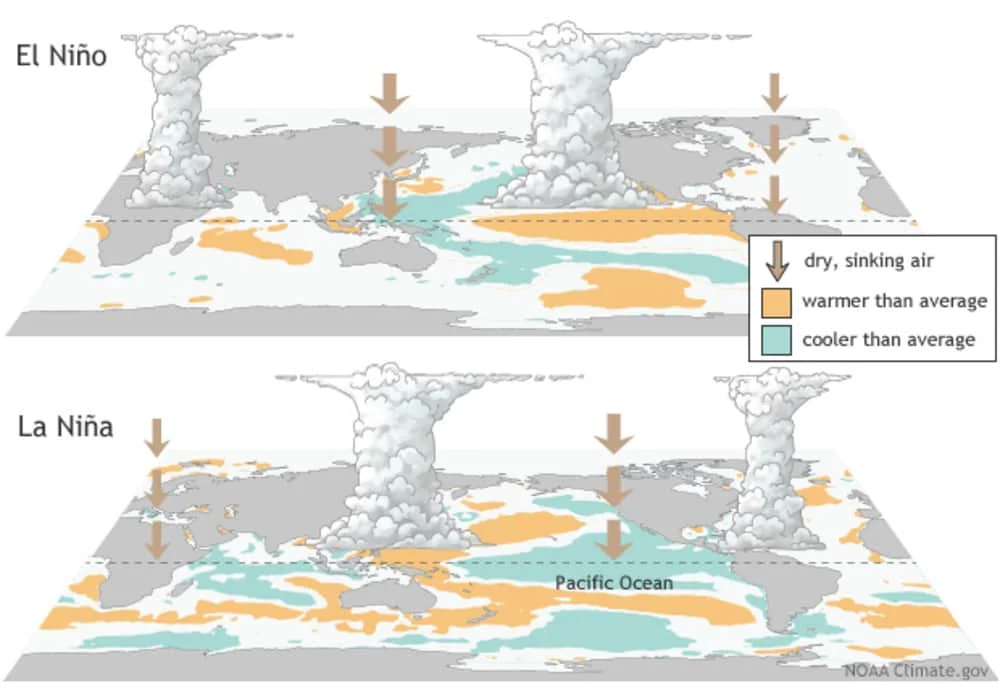EL NINO – LA NINA: CLIMATE ANOMALIES
El Nino and La Nina are climatic phenomena that originate from a significant temperature anomaly in the surface water of the South Pacific Ocean. When this becomes particularly marked and positive, we witness an El Niño episode, but in the opposite case (significant thermal deficit) it is the La Niña phenomenon. The two phenomena were named in the late 1800s by Peruvian sailors who then noticed the appearance of a warm current at Christmas time hence El Niño (the little boy in Spanish) and La Niña (the little girl). The EL NINO phenomenon, of oceanic origin, is characterized by the warming of an immense reservoir of surface water which extends from the center of the Pacific Ocean to the coasts of Peru and Ecuador in the East.
EL NINO phenomenon
This hot sea surface temperature anomaly occurs more or less intensely and is accompanied by more or less pronounced climatic repercussions every 3 to 6 years on average (over the past 30 years, the cycle has been close to 5 years).
The most recent one began in the first half of 1997 and lasted barely more than a year, until around June 1998: this El Niño 97/98 phenomenon is however among the most intense of the century, its impact having been felt almost everywhere. on the equatorial and tropical belt of the globe.
Impacts of EL NINO on the Caribbean Basin and the North-East Atlantic
- Relative drought over the Caribbean.
Drought was marked in Martinique and Guadeloupe from June 1997 to May 1998. A deficit of around 30% on average was observed there.
Moreover, 1997 was the driest year on Grande-Terre in Guadeloupe for 50 years!
- Cyclonic activity reduced during 1997.
Only 7 cyclonic phenomena named in the area: 4 Tropical Storms and 3 Hurricanes, with particularly inactive months of August and September with a single cyclone evolving over the North Atlantic …
What is called LA NINA, as opposed to the historical term of El Niño, corresponds to the cold phase of this phenomenon of thermal oscillation of the Eastern Pacific, or if one prefers to a positive Southern Oscillation index.
When surface waters become colder than normal over these regions of the eastern Pacific, this is accompanied by very sustained trade winds over the equatorial belt, and by an elevation of the “thermocline” of these regions, this being defined as the thickness of ocean water where the thermal gradient is the strongest, that is to say where a rapid change in temperature is observed from the surface to deeper waters. One of the first consequences is the increase in rains over the Western Pacific.
LA NINA phenomenon
If this so-called La Niña phase is less well-known than its El Nino counterpart, it is probably because there were few episodes where it really manifested itself during the last 2 decades.
However, the rapid succession of very different, even extreme climatic conditions during the switch of the El Niño phenomenon towards its opposite La Niña, brings significant “stress” to the environment.
The case of Indonesia is a perfect example: last year’s severe drought was followed by heavy rains this year. In fact, the drought had caused gigantic forest fires which left large areas devoid of vegetation. This year, the strong episode of La Niña was accompanied by very heavy rains in these same areas, causing flooding, landslides and mudslides.
Chinese researchers have also indicated that torrential rains over central China are more likely the year after the occurrence of an El Niño phenomenon, but this still needs to be studied more fully.
While the effects of La Niña, common to those of the usual monsoon rains in these parts of South and Southeast Asia, have sometimes been considered less obvious than those attributed to El Niño, it turns out that as we can see now, we can list them as we did for El Niño.
CONSEQUENCES OF LA NINA ON GENERAL OCEAN CIRCULATION
AND THE ATMOSPHERE – OCEAN / ATMOSPHERE INTERRACTION
- The weather equator is moving north.
- The trade winds are strengthening over the Pacific.
- Sea currents are changed.
- Higher than normal precipitation appears over the western part of the equatorial Pacific (especially towards Indonesia), South and Southeast Asia, northern and northeastern Australia, southern Africa, northern South America (including Brazil) and Central America (including the West Indies), the Hawaiian archipelago…
- Severe periods of drought are observed on the intertropical islands of the Central Pacific, on all the south of North America (American states bordering the Gulf of Mexico in particular), the north of Mexico and California, in Africa of the Center and of the east, parts of south-east and south-west of South America…
The climatic disorders linked to La Niña are henceforth considered, thanks to the studies carried out in recent years, as not insignificant and sometimes as intense as those generated by El Niño. Of course, if these climatic impacts are typical of this phenomenon, this does not mean that there are not other very influential factors too, such as the internal dynamics of the atmosphere, the surface temperature fields of the sea on the other oceanic basins local surface conditions as well as the inevitable regional climatic variability.
Coupled ocean-atmosphere numerical models have started to provide forecasting tools that will allow climatologists to take into account all these influencing parameters when establishing their seasonal forecasts.
WHAT HAPPENEDIN 1998?
Conditions of occurrence of La Niña appeared over the tropical Pacific Ocean, immediately after the dissipation of the El Niño phenomenon of 97/98, towards the end of the 1st semester of the year 1998. This episode begins ” cold “began in May and June with an extremely rapid decrease in ocean surface temperatures. Admittedly, the rate of cooling has slowed down a bit since then, but in October, sea temperatures were significantly lower than normal on the South American coasts up to the area surrounding the date line (around 180 ° W).
Currently, at the end of October 1998, the surface water temperatures of the central and western regions of the Indian Ocean are at values reaching their lowest level since the beginning of the year. Conversely, during this time, the sea warmed in the Western Pacific (towards Indonesia in particular) and in the Eastern Indian Ocean (towards Australia).
These thermal changes are accompanied by changes in the ocean circulation in the Pacific where, by the end of August, the equatorial thermocline was closer to the surface than usual (less than 40 meters deep) between the coasts of North America. South to west of 140° W.
In connection with these changes in sea temperature, areas of strong convective instability have returned to their usual regions, in the western Pacific and in the eastern Indian Ocean. Heavy rains have therefore been observed over Indonesia, including Borneo, since August and much of Australia is once again experiencing very wet weather.
We can also expect that other impacts of heavy rainfall related to La Niña will still occur if this ongoing “cold” episode continues to develop.
IMPACTS ON THE CARIBBEAN BASIN AND NORTHEAST ATLANTIC
A relative humid period in the Caribbean and a marked rainy season
The rainy season 98 is well marked from July to October both in Martinique and Guadeloupe with rainfall surpluses of around 20 to 40%.
Very strong cyclonic activity from the end of August 1998
Total of 13 named cyclonic phenomena over the vast Atlantic area: 4 Tropical Storms and 9 Hurricanes including 4 of strictly “Cape Verdean” origin.
On September 25 and 26, for the first time in the century, 4 hurricanes exist simultaneously over the North Atlantic, GEORGES, IVAN, JEANNE and KARL.
OUTLOOK
There is a good agreement, in terms of climate forecasting, of the various dynamic and statistical models which predict a continuation of the decrease in surface temperatures of the tropical zone of the Pacific Ocean until the end of the year. It can therefore be argued that the climatic impacts already observed around the world linked to La Niña should continue to continue over the next few months.
On the other hand, forecasts of surface temperatures of the Atlantic and Indian Oceans are only made in a few centers, and are known to be of lower quality than those for the Pacific Ocean. However, we know that these oceans play an important role in the evolution and distribution of precipitation on the continents which border them (Africa and South America in particular) and can also contribute to certain climatic variability in other regions of the globe.
Thus, the uncertainties in such forecasts induce additional inaccuracies in the climate forecasts that can be established for these regions.
As for the Atlantic area, September saw 8 named cyclones (from DANIELLE to KARL), cyclonic activity was intense for several weeks with some particularly deadly extreme phenomena (GEORGES then MITCH). We cannot deny the influence of La Niña on this explosion of cyclones in our regions…
What is the difference between El Nino and La Nina?
Unlike El Niño, deep convection is reinforced over the western part of the basin while the trade winds are also increasing in intensity. During La Niña episodes, the sea surface is even higher in the west of the Pacific Ocean compared to the east.
El Niño and La Niña are climatic phenomena, NOT a meteorological phenomena! Why?
El Niño and La Niña correspond to the two opposite phases of the coupled ocean / atmosphere phenomenon called ENSO (El Niño / Southern Oscillation)…. We know that it is linked to a cycle of variations in atmospheric pressure between the east and west of the Pacific, coupled with a cycle of the ocean current along the equator.
Symply, El Niño–Southern Oscillation (ENSO) is an irregular periodic variation in winds and sea surface temperatures over the tropical eastern Pacific Ocean, affecting the climate of much of the tropics and subtropics. The warming phase of the sea temperature is known as El Niño and the cooling phase as La Niña.
Sources: PinterPandai, National Geographic, National Oceanic and Atmospheric Administration (NOAA), National Ocean Service, National Environmental Education Foundation (NEEF), United Nations Office for the Coordination of Humanitarian Affairs
Photo credit: National Oceanic and Atmospheric Administration



